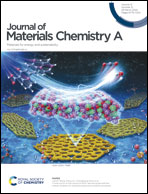Correction and new understanding of the reactivity of illuminated tungsten trioxide in the dark: antecedents and consequences of photo-storage electrons triggering Fenton reactions†
Abstract
Water treatment via photocatalytic steps is severely constrained by the alternation of day and night and the shading of sunlight by clouds. As an energy storage photocatalyst, WO3 has been reported to function partially even under dark conditions, which is of great significance for the construction of round-the-clock photocatalysts. However, pertinent reaction processes, especially the function of stored electrons in WO3 during catalytic reactions in the dark, have not been fully analyzed. Herein, we synthesized hexagonal WO3 hydrate (h-WO3·0.46H2O) and used extensive experiments and theoretical calculations to investigate its structure, photochromic capability, and dark reaction activity. Due to the strong interaction between the protons from lattice water and bridging oxygen atoms (W–O–W), h-WO3·0.46H2O exhibited unexpected irreversible photochromic properties under visible light. Our study is the first to show that light-irradiated h-WO3·0.46H2O can activate H2O2 to form ˙O2−, ˙OH, and 1O2, which are responsible for the efficient degradation of organic pollutants, but it could not produce reactive oxygen species (ROS) via the 1e−/2e− ORR in the dark. This study not only provides a novel and inexpensive Fenton catalyst for wastewater treatment, but also proposes a new approach for utilizing solar energy under dark conditions.



 Please wait while we load your content...
Please wait while we load your content...